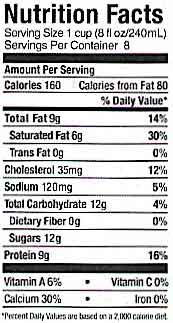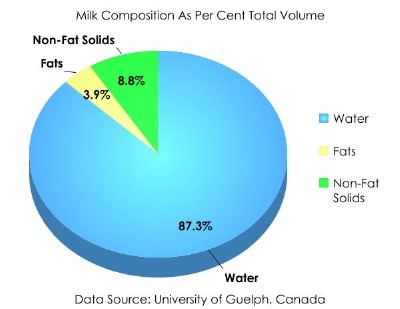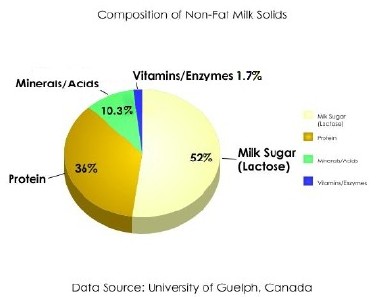What's in Raw Milk?

Just what is in raw milk? Think of it is as an oil/water emulsion. It's also known in some circles as a colloidal suspension.
To make every gallon of milk, a cow must pump from 600-800 gallons of blood through her udder. Think of that next time you pour yourself a glass. That cow poured her heart into it!
Whole raw milk's composition varies slightly among cow species, type of food and other conditions, so the figures below (and, at right, from a commercial raw milk dairy) are only approximations.
Here's a rough breakdown in percent of total volume:
Water 87.3%
Milk Fats 3.9%
Non-fat Solids (Protein, Milk Sugar, Immune Factors, etc.) 8.8%

A. Casein Proteins (~80% of Total Milk Protein-TMP)
1. Alpha s1 [30.6%]
2. Alpha s2 [8.0%]
3. Beta [28.4%]
4. Kappa [10.1%]
B. Whey Proteins (~20% of TMP)
1. Alpha lactalbumin [3.7%]
2. Beta lactoglobulin [9.8%]
3. Bovine Serum Albumin (BSA) [1.2%]
4. Immuoglobulins [2.1%]
5. Proteose peptone [2.4%]
Milk Sugar (Lactose) 4.6%
Minerals 0.65%
Calcium
Phosphorus
Magnesium
Potassium
Sodium
Zinc
Chlorine
Iron
Copper
Sulfates
Bicarbonates
Trace Elements
Acids 0.18%
Citric
Formic
Acetic
Lactic
Oxalic
Vitamins/Enzymes 0.12%

Raw Milk Fats:
Few words are as highly charged in the food world as "fat." Perhaps "lipid" would be a better word. Please see my Fat Primer for images and more information on this wonderful, energy-laden food group.
In milk, more than 95% of the fats form into spherical shaped objects called globules from 0.1 to 15 microns in diameter (that's pretty tiny- a micron is a millionth of a meter, or roughly 25,400 to the inch.)
Just over 98% of the lipids in milk are in the class known as triglycerides- a glycerol molecule (glycerin) with three fatty acids (of various lengths and saturations) attached. There are ten major fatty acids found in milk to varying degree:
Butyric Acid 4 (# of Carbon atoms)
Caproic Acid 6
Caprylic Acid 8
Capric Acid 10
Lauric Acid 12
Myristic Acid 14
Palmitic Acid 16
Stearic Acid 18
Oleic Acid 18:1 (one double bond)
CLA 18:2 (two double bonds)
Milk also contains cholesterol, another controversial and dreaded word. For the most part, it's located in the cores of fat globules, and amounts to roughly 0.3% of all milk lipids. The less we get in our diets, the more our bodies make on their own. Check out my Cholesterol Primer to get the straight scoop on why this much-maligned substance is essential to our health.
Raw Milk Proteins:
Proteins are complex molecules comprised of long chains of amino acids. Depending on interactions between some of the amino acids, the molecules can twist into helical formations or pleated sheets (secondary structure). Tertiary proteins undergo further coiling and folding. When clustered together somewhat spherically, they are known as globular proteins. Fibrous tertiary proteins are formed when two or more long strands of amino acids form links along their length.
The caseins, normally highly digestible in the intestinal tract, are relatively heat stable. Being secondary in structure, and so without much complex structure to unravel, they survive the heat of pasteurization (145-160 deg. F.) fairly well. After ultra-high temperature (UHT) pasteurization (280-305°F./138-152°C.) their fate is uncertain.
The whey proteins,including the immunoglobulins, are very sensitive to heat (heat labile) and denature well below the heat of normal pasteurization.
Incidentally, the denaturation of whey protein affects the whiteness of milk. Milk gets whiter after it's processed.
By the way, did I mention that not all raw milk is the same? It's not. Check my About Raw Milk page to find out why.
Milk Sugar:
Lactose, the first carbohydrate most baby mammals ever taste, is actually made up of two simple sugars, glucose and galactose, making it a disaccharide. Cow's milk hovers at around 5% lactose (human milk averages a bit higher at just over 7% by comparison). It's got a fairly low glycemic index (doesn't boost insulin levels very quickly) and so is better tolerated by diabetics.
As some people age, their levels of lactase, the enzyme needed to digest lactose, drop significantly. When they consume heat treated dairy products with no remaining food enzyme activity, they lack sufficient lactase to break the milk sugar down, and suffer numerous unpleasant symptoms, notably gas and bloating. Not fun. But raw milk, with live, friendly lactobacilli, has its bacterially-produced lactase intact, so chances are good these folks may be able to tolerate it.
Another way to enjoy the benefits of dairy with almost none of the lactose, is to eat fermented products such as yogurt and kefir. The friendly microbes, during the fermentation process, have consumed pretty much all the lactose, turning it into the sour tasting lactic acid that's such a powerful antimicrobial agent.
Raw milk cheeses are another tasty way to enjoy dairy without the lactose. Again, most of the lactose is consumed in the fermentation process.
Minerals in Raw Milk:
The mineral content of milk varies with a host of conditions as well. Soil quality, geographical location, species of cow, health of the animal- all these factors and more come into play.
Accesibility to raw milk's mineral content is dependent upon its enzymes and other factors remaining functional. Here are some approximate values for mineral levels in the average quart of raw milk:
Mineral Content per quart (Typical range):
Sodium__330-850mg
Potassium__1040-1600mg
Chloride__850-1040mg
Calcium__1040-1225mg
Magnesium__85-130mg
Phosphorus__850-940mg
Iron__280-570ug
Zinc__1880-5660ug
Copper__95-570ug
Manganese__19-47ug
Iodine __~245ug
Fluoride__28-207ug
Selenium__4.7-63ug
Cobalt__0.47-1.23ug
Chromium__7.5-12.3ug
Molybdenum__17-113ug
Nickel__0-47ug
Silicon__700-6600ug
Vanadium__trace-290ug
Tin__38-470ug
Arsenic__19-57ug
Vitamins in Raw Milk:
Raw milk contains every known fat and water soluble vitamin. To get them all, make sure you drink whole raw milk or you'll miss those lost in the skimming process.
Vitamin C levels, already fairly low in cow's milk (typically less than 20mg/quart- about half the level found in human milk), have been shown to drop further when exposed to ultraviolet light such as from sunlight or fluorescent lights. Store it in the dark at home, and ask your store to look into UV filters for their cold-case lights. Here are some approximate but typical amounts of vitamins found in raw milk:
Vitamin Content per quart (Approximate):
A__375ug
C__19mg
D__38IU
E__940ug
K__47ug
B1__425ug
B2__1650ug
Niacin__850ug
B6__470ug
Pantothenic acid__3300ug
Biotin__33ug
Folic acid__52ug
B12__4.25ug
Enzymes in Raw Milk:
Yet another controversial topic, and important enough to deserve a website all its own, the enzymes in raw milk are crucial in making it the valuable healing food it is.
The arguments range from their having no digestive benefit because they can't withstand the acid environment of the stomach, to outright denial of their existence.
No one can truthfully or knowingly deny that these powerful but fragile protein-based substances are in milk for a purpose. Getting people to agree on that purpose is another matter entirely!
To understand their importance, it's helpful to know what enzymes are, and what they do in foods and in our bodies.
Basically, enzymes are complex forms of protein (made out of amino acids) that can change (catalyze) other substances without taking part in the reaction themselves. In digestion, for instance, they help break down starches, fats and proteins into chunks the body can use.
Here's a list of the more important enzymes in raw milk:
Amylase
Catalase
Lactase-(through bacterial synthesis)
Lactoperoxidase
Lipase
Phosphatase